Button mushroom, by its scientific name Agaricus bisporusIt takes its name from its original place of cultivation, the Paris region. In fact, from the 17th century, its cultivation developed in quarries and catacombs around Paris, under the leadership of Jean-Baptiste de la Quintigny, Louis XIV's gardener at Versailles. The king loved this wild mushroom, nicknamed the “meadow rose.”
In the 19th century, mushroom cultivation intensified in underground galleries and old abandoned quarries south of Paris. Constant humidity and temperature conditions are ideal for its growth. In 1875, at least 300 Parisian producers grew the valuable mushrooms and sold 3,000 tons annually in Halle de Paris.
But at the beginning of the twentieth century, construction work on the Paris metro forced farmers to leave the basements of the capital. Mushroom cultivation was then transferred to the Saumur region of Pays de la Loire, where it continues today. The region produces 3/4 of current French production, estimated at 200,000 tons per year.
Characteristics and culture
Button mushrooms grow on a substrate made from horse manure, which is used as fertilizer. It requires constant humidity and darkness, hence its original development in underground Parisian galleries.
There are three types of mushrooms: white, cream, and blonde. It is part of the Agaricaceae family and is characterized by its round, dome-shaped cap, firm white flesh, and short stem.
Button mushrooms are grown all year round, but it is recommended to choose mushrooms with a well-opened, light-colored cap to ensure the best taste. It is recommended to clean it carefully without immersing it in water, so that its flavor does not change.
Nutritional value
Button mushrooms have many nutritional benefits:
- It is low in calories, containing only 21 calories per 100 grams.
- It is rich in water by 90%, and can be consumed in moderation as part of the diet.
- Contains 2.5 grams of carbohydrates per 100 grams, including fibre. This increases the feeling of fullness.
- It is a source of vegetable protein with a ratio of 3 grams per 100 grams.
- It contains many vitamins and minerals: vitamins B2, B3, B5, B9, D, but also potassium, phosphorus and copper.
- It contains antioxidants, which are compounds that reduce cell damage.
- It contains beta-glucan and soluble fiber, which have positive effects on health.

Image source © Docteur-fitness.com
Health benefits
Thanks to its composition, button mushrooms provide many benefits:
- It helps regulate cholesterol levels and reduces cardiovascular risks. Beta-glucan and fiber reduce the absorption of dietary cholesterol.
- It improves blood sugar and insulin resistance in type 2 diabetics according to some studies. A low glycemic index regulates the release of glucose into the blood.
- The antioxidants in it protect cells from aging and diseases such as cancer. It also stimulates the immune system.
- Vitamin D, rare in the plant kingdom, is beneficial for bone and dental health.
- Rich in vitamin B9, it promotes the production of red and white blood cells. When combined with vitamin B12, it prevents anemia.
- Minerals such as potassium are essential for nerve transmission and muscle contraction.

Image rights © Adobe Stock
Button mushrooms are a versatile culinary ingredient. You can taste it:
- Raw, in salads or as a spread;
- Cooked in a pan, in an omelet, in a tart, in a quiche;
- In velouté or in sauce to accompany meat and fish;
- Stuffed with meat, cheese or vegetables.
It is recommended not to cook it for a long time and combine it with garlic, herbs or spices to enhance its wonderful flavour.
Your frequently asked questions
what is the difference with Mushroom?
Button mushrooms and champignons belong to the same species Agaricus bisporus. The only difference is the way they are grown: button mushrooms are grown in underground halls while mushrooms grow on a substrate outdoors.
Can you eat it raw?
Yes, mushrooms can be eaten raw or in salads, for example. But it is best to cook it lightly to make it easier to digest.
Can you freeze it?
Yes, button mushrooms freeze well. Simply wash, dry, cut into pieces and place in freezer bags. Once thawed, it regains its firm consistency.
Does it cause allergies?
Like all mushrooms, button mushrooms can cause allergic reactions in sensitive people. However, this allergy remains rare. If in doubt, it is best to consult an allergist.
Is it not recommended during pregnancy?
No, mushrooms are safe to eat during pregnancy. Rather, it is an interesting food for its vitamin B9 content, which contributes to the good development of the fetus.
Can you grow it at home?
It is very difficult to grow mushrooms yourself because they require very specific growing conditions. It is better to resort to types of mushrooms that are easier to grow, such as oyster mushrooms or shiitake mushrooms.
The last word
Thanks to their low calorie content and richness in essential nutrients, button mushrooms are an everyday favorite. Its beneficial effects on cardiovascular health, diabetes regulation and the immune system make it an essential component of a healthy, balanced diet. They are easy to cook, can be enjoyed raw and cooked and can be used in many preparations.
(Tags for translation)Properties and cultivation
Why is it so popular?



نحن نحب سماع آرائكم!
شاركنا رأيك أو اطرح سؤالاً في قسم التعليقات أدناه